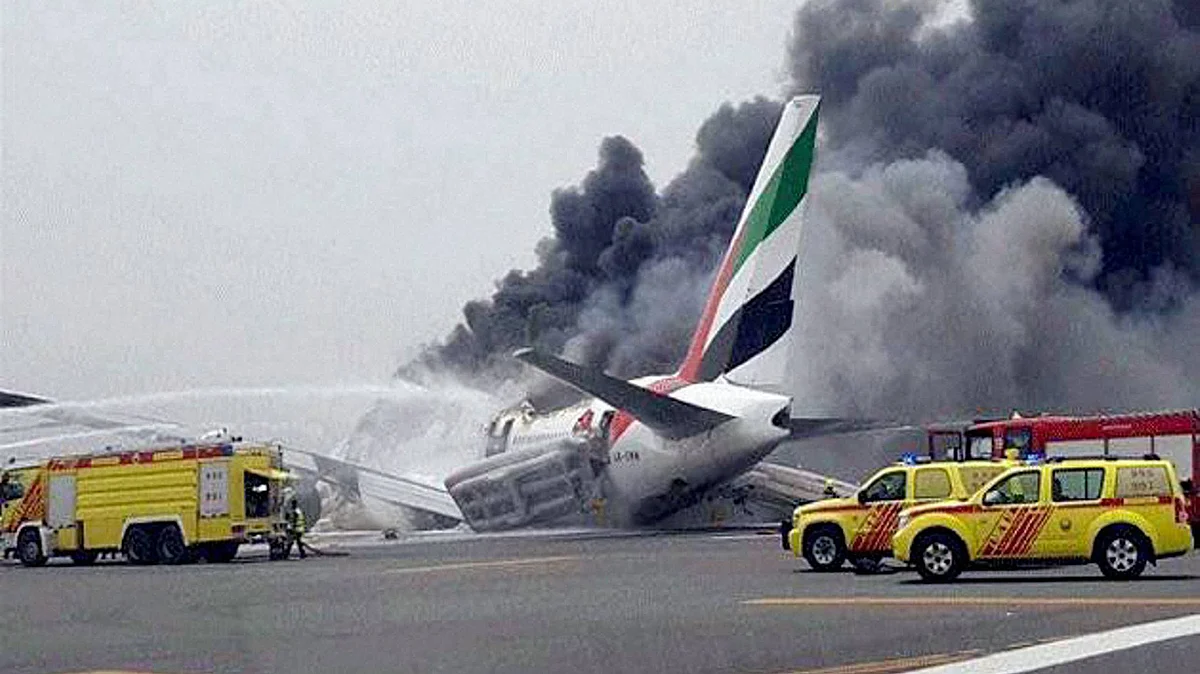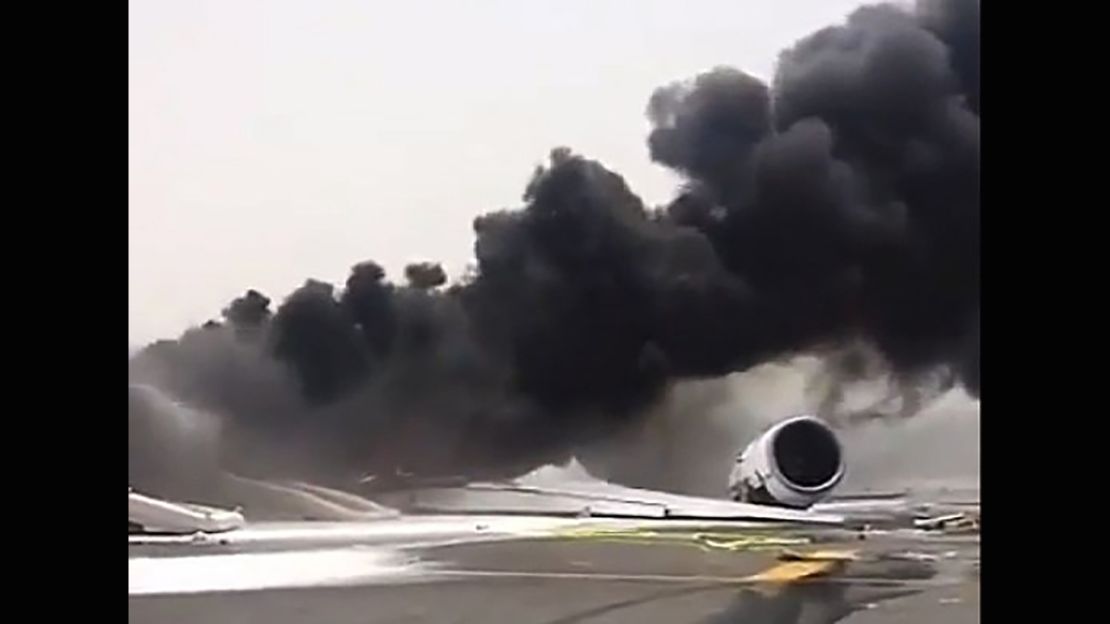
On what began as a typical Wednesday at Dubai International Airport, one of the world’s busiest aviation hubs, an Emirates flight approaching from India experienced a dramatic emergency that would become the focus of global attention. Flight EK521, traveling from Thiruvananthapuram to Dubai, crash-landed shortly before 1 p.m. local time.
Remarkably, all 300 people on board — 282 passengers and 18 crew members — survived. Yet the day was marked by tragedy: one firefighter lost his life while responding to the blaze that followed the aircraft’s landing.
The incident, though frightening, showcased the effectiveness of emergency protocols, the professionalism of the crew, and the fast mobilization of airport rescue teams. It also triggered one of the most comprehensive investigations in the region’s aviation history.
A Routine Descent That Changed Abruptly

Flight EK521 had been traveling normally throughout most of its journey. The weather in Dubai that day was hot and breezy — typical for the summer months — with reports of possible wind shear, a sudden change in wind direction or speed that can pose challenges during landing.
As the aircraft, a Boeing 777-300, began its final descent, passengers believed they were minutes away from disembarking. According to onboard accounts, the approach initially felt routine.
However, passenger Iype Vallikadan later told the Associated Press that the pilot made an unexpected announcement moments before landing, informing passengers of a suspected issue with the landing gear. The crew prepared the cabin for a potential emergency landing, instructing passengers to remain calm and brace if necessary.
Shortly after touchdown, something went wrong. The aircraft did not settle on the runway as expected and instead came to a sudden, forceful halt. Within moments, smoke became visible, and cabin crew immediately initiated evacuation procedures.
The Evacuation: Minutes That Mattered

According to Emirates, all emergency exits were opened immediately, and evacuation began within seconds. Videos and images posted on social media showed passengers sliding down inflatable slides as thick smoke rose behind them.
The success of the evacuation came down to two crucial factors:
1. Well-trained cabin crew
Flight attendants followed strict safety protocols established for aircraft emergencies. Passengers later described them as calm, composed, and highly directive — repeating instructions, guiding people toward exits, and ensuring no one stopped to retrieve personal belongings.
2. Rapid airport response
Dubai International Airport’s rescue teams, trained for high-pressure aviation incidents, arrived almost instantly. Their priority was to contain the fire, clear the runway, and support medical teams evaluating passengers.
Even with the aircraft engulfed in flames shortly after the evacuation, the crew successfully cleared the cabin in mere minutes — a testament to training and preparedness.
Tragic Loss of a Firefighter

While all passengers and crew survived, the incident claimed the life of one firefighter, who was fatally injured during efforts to control the blaze.
Ahmed bin Saeed Al Maktoum, the airline’s chairman and CEO, confirmed the loss in a press briefing, calling it a “selfless act of service” and expressing condolences to the firefighter’s family and colleagues.
The firefighter’s identity, though not widely publicized, became a symbol of the silent risks faced by emergency responders who run toward danger as others escape it.
The Passenger Manifest: A Global Flight
Emirates released the nationalities of those on board, reflecting the diversity typical of flights traveling through Dubai, a major international hub.
Among the 282 passengers were:
-
226 from India
-
24 from the United Kingdom
-
11 from the United Arab Emirates
-
6 each from the U.S. and Saudi Arabia
-
5 from Turkey
-
4 from Ireland
Several other countries were represented with one or two passengers each, including Australia, Brazil, Germany, Malaysia, Thailand, South Africa, the Philippines, Switzerland, Croatia, Bosnia and Herzegovina, and Tunisia.
The global passenger list highlighted the far-reaching impact of the incident, with families and governments worldwide awaiting updates.
Inside the Investigation: What Authorities Sought to Understand

Dubai’s General Civil Aviation Authority (GCAA) activated its investigation team almost immediately. They worked alongside Emirates, Boeing, and international aviation safety organizations.
The primary goals were to determine:
1. The exact cause of the crash-landing
Early speculation pointed to possible wind shear, but investigators emphasized that no conclusions should be drawn until a full review of the flight data and cockpit voice recorders.
2. The sequence of mechanical and operational events
Investigators examined:
-
landing gear functionality
-
pilot communications
-
thrust settings
-
runway conditions
-
weather data
-
emergency systems performance
3. Crew response and evacuation effectiveness
Given how quickly the fire escalated after landing, researchers assessed whether evacuation procedures minimized harm — and whether future protocols could be improved.
4. Fire progression and airport response
The tragic loss of the firefighter prompted an additional layer of review into safety procedures, protective equipment, and fire behavior patterns.
Boeing announced that it sent a technical support team to assist the investigation, following global aviation protocols for aircraft manufacturers.
Dubai Airport’s Immediate Challenges
Dubai International Airport, which sees over 78 million passengers annually, faced significant disruptions. Departures and arrivals were diverted or delayed for up to six hours while emergency teams secured the runway and assessed structural damage.
Despite the large-scale disruption, airport officials emphasized that safety assessments must come before operational concerns. By 7 p.m., flight operations gradually resumed.
Emirates’ Reputation and Safety Record
Founded in 1985, Emirates has grown into the Middle East’s largest airline and one of the world’s most recognized brands. Before this incident, the airline had maintained a notably strong safety record.
Aviation experts highlighted that the successful evacuation of all passengers — despite the aircraft becoming engulfed in flames soon after — underscored both Emirates’ training standards and the robust safety design of modern aircraft like the Boeing 777.
While the crash-landing marked a rare and serious event for the airline, analysts pointed out that the outcome could have been far worse without proper training and the quick actions of the crew.
The Human Perspective: Relief, Gratitude, and Reflection

For passengers, the experience was terrifying yet life-changing. Many described a moment of disbelief when they realized smoke was spreading through the cabin. Others recalled the overwhelming relief of stepping onto the runway.
Several passengers shared stories expressing gratitude:
-
to the crew who stayed composed under pressure,
-
to the pilots who made critical decisions,
-
and to the firefighter who lost his life ensuring their safety.
Families across multiple continents waited anxiously for updates, and social media platforms saw an outpouring of support and sympathy.
A Reminder of Aviation’s Complex Realities
Though commercial aviation remains statistically one of the safest modes of travel, incidents like EK521 are reminders of the delicate coordination between weather, machinery, human skill, and emergency readiness.
The crash-landing set off important discussions across the aviation community, prompting reviews of:
-
wind shear monitoring
-
real-time pilot decision support
-
runway emergency protocols
-
communication between cockpit and ground crews
Looking Ahead
As investigators continue analyzing data from the aircraft’s flight recorders, additional findings and recommendations are expected to be released. These insights will likely contribute to further improvements in aviation safety — not just for Emirates, but for airlines worldwide.
For now, the incident stands as:
-
a story of survival for hundreds of passengers,
-
a demonstration of professionalism by emergency crews,
-
and a solemn reminder of the risks faced by first responders.
The memory of the firefighter who gave his life, and the collective relief over the successful evacuation, remain at the heart of the story — a testament to courage, coordination, and the unwavering commitment to passenger safety.